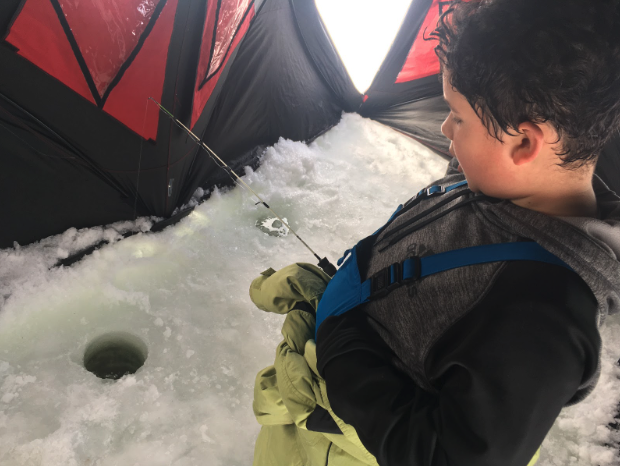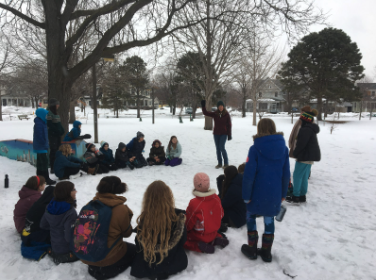written by Kyla Sisson and Brent Cummins, Outdoor Education guides
This winter, upper elementary students had the opportunity to investigate ice and snow in unique ways through partnerships with two organizations, Ardent Outdoors and the Cedar Creek Ecosystem Science Reserve, part of the University of Minnesota.
Little Elk students hold Northern Pike before returning them to Como Lake.
Ardent Outdoors is a nonprofit dedicated to helping all communities access the outdoors. During the summer, they are known as the Dive Guys, using scuba gear to remove invasive aquatic species from lakes. But in the winter, they give back through introducing kids and veterans to ice fishing.
Ardent Outdoors explain safe ice thickness.
Ice fishing isn’t just a recreational sport. Catch and release is one way to observe and form a relationship with aquatic life, even in the depths of winter. Before going fishing, students learned about fish species who call Como Lake home. We applied algebra to calculate safe ice thickness for different amounts of weight. Using magnetic models from the Science Museum, we investigated the polar properties of H20 that cause solid water to float instead of sink, allowing lakes to support life throughout the big freeze. Then we were ready to make the trek to our closest body of water.
Jigging with a pole for panfish.
Students learn to drill a hole and set a tip-up.
We were lucky to have some warm days for fishing this year. Though some students worried about melting ice, the Dive Guys helped them measure the thickness – between 14 and 18 inches of ice – and they quickly acclimated to the power of “walking on water.” Ardent Outdoors provided warm tents for a cozy afternoon on the lake. Students learned to bait meal worms on hooks and jig for pan fish, which yielded one or two crappie, but the real excitement was in getting to meet the Northern Pike. Tip-ups are baited for larger fish, popping up a bright flag when one bites. Some students helped drill holes and set tip-ups, then staked a lookout, ready for the big one. For one class, the tip-ups yielded four northern pike, which we had the opportunity to observe for an extended time. Students learned how to care for the fish by refreshing oxygen levels in the shallow water of a well dug into the ice, gently felt their scales, watched their swimming behavior and interactions, and were able to tell each fish apart before they released them back to lake life.
Back on land, we continued our study of frozen water with Dr. Kara Baldwin from the Cedar Creek Ecosystem Science Reserve. This UMN field study site holds ongoing research about climate’s effects on forests, prairies, bogs, and the animals who call them home. Thanks to generous sponsorship funds from Cedar Creek donors, Dr. Kara came to us to provide a place-based science program in our neighborhood park. Students created snow study plots, where they collected data to tell the story of this winter. Using tools from Cedar Creek, they measured the thickness and temperature of each snow layer and calculated the amount of water held by the snow. Dr. Kara also answered “Ask a Scientist” questions from students about Cedar Creek experiments and what a scientist’s job is like.
Thank you to both Ardent Outdoors and Cedar Creek for partnering with our students to create such icy cool environmental studies!







